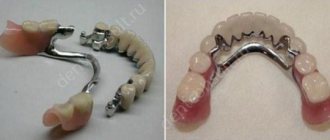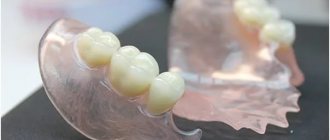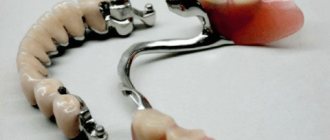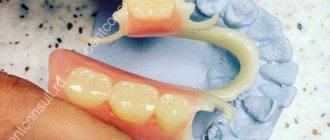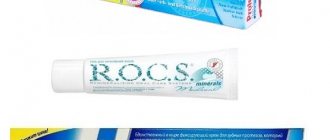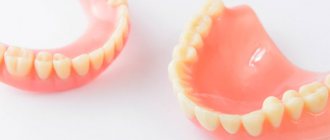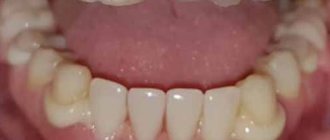Chief editor of the site:
Snitkovsky Arkady Alexandrovich
Chief physician of the professorial dentistry “22 Century”, dentist, orthopedic dentist
Author of the article:
Scientific team of dentistry “22 Century”
Dentists, candidates and doctors of medical sciences, professors
Scientific research in dentistry has shown that the processes of bone tissue regeneration and socket healing under a direct plate immediate prosthesis proceed much faster.
Loss of teeth and associated dysfunctions in chewing, speech, and appearance negatively affect the patient’s well-being. The nature and degree of this influence depends on the gender and age of the patient, profession, type of higher nervous activity, as well as on which teeth are lost. The loss of front teeth, violating aesthetic standards, can cause different reactions in a young man, a girl or an elderly person. For teachers, artists, journalists and many other specialists, the loss of front teeth means a temporary cessation of work, so the patient’s desire to receive a prosthesis as quickly as possible and to some extent compensate for the resulting defect in the dentition is understandable. In our clinic, one of the most effective ways to eliminate defects resulting from tooth extraction is the manufacture and installation of immediate dentures (direct prosthetics). This method consists in the fact that dentures are prepared before surgery, and then, immediately after the teeth are removed, they are fitted to the jaws. Scientific research in dentistry has shown that the processes of bone tissue regeneration and socket healing under a direct plate immediate prosthesis proceed much faster.
Installation of immediate dentures allows you to maintain the height of the lower part of the face, which can be changed as a result of the removal of teeth that hold the occlusal height, to evenly distribute the load on the remaining teeth and the prosthetic bed.
Immediate prosthetics are used in cases where the state of tooth mobility allows an impression to be taken without fear of removing the tooth at the time of taking the impression.
Immediate dentures in Moscow dentistry
An immediate dental prosthesis is a temporary structure to replace a lost tooth or several teeth for aesthetics and functionality while the patient undergoes the process of preparing for implants or permanent dentures.
It will take several weeks to create implants or permanent prostheses. Therefore, immediate dentures allow a person not to be left without teeth for a single day. The name comes from English. “immediate” - “instantly”, “immediately”. The patient came with his teeth and after the end of the dentist’s appointment he leaves with his teeth. Immediate dentures help the patient to rehabilitate faster, restore phonetic, aesthetic and chewing function in the shortest possible time.
Implantation or creation of permanent prostheses takes from several days to several weeks, in complex cases of therapeutic treatment up to several months. A beautiful smile is needed every day; an immediate denture is an excellent alternative while waiting for a permanent structure.
It can be installed in many dental clinics in Moscow; the cost starts from 3,600 rubles for the simplest design. On our portal you can find the clinic closest to your home, choose a doctor based on patient reviews, and look at his rating.
How to determine quality
Temporary orthopedic structures are made of plastic. They are not as strong and reliable as permanent ones, but should provide normal chewing function until the denture procedure is completed. High-quality dentures meet the following criteria:
- Aesthetics.
- Hypoallergenic.
- Comfortable to wear.
- Strength.
When a product meets these requirements, it will not only allow you to lead a normal life, but also reduce the period of adaptation to prostheses.
Indications for installation of immediate dentures
1. Absence of front teeth, since the gingival margin is invisible during use.
2. Removal of the last teeth, the design of the prosthesis allows it to be worn comfortably.
3. Periodontopathy, and as a result, removal of lateral teeth. This requires closing the defect.
4. Use as permanent dentures in case of a large defect to properly distribute the load on your teeth.
5. Bilateral defects, tooth loss and chewing dysfunction.
6. It is not possible to carry out fixed prosthetics; they are placed in place of the chewing teeth.
7. Serves as a temporary structure for the duration of therapeutic treatment of a patient preparing for the installation of fixed prostheses or implantation.
8. A removable immediate denture is not only aesthetically pleasing, but also prevents a decrease in the volume of bone tissue under the artificial tooth. Functional in the process of chewing food.
9. Help prepare for further prosthetics, especially useful for patients who have been missing teeth for a long time. Makes it easier to get used to having permanent dentures after edentia.
10. Protects the remaining natural teeth from changing position in the oral cavity.
11. Copes with the chewing load, performing the function of a lost tooth (teeth).
12. Unloading of the TMJ, ensuring the physiological function of chewing.
Service life and care
The acceptable duration of use of immediate dentures is only a few months. This time is usually more than enough to create a permanent orthopedic system. At the same time, the butterfly prosthesis also requires high-quality care and maintaining a high level of hygiene. Otherwise, the development of inflammatory processes in the fragile soft tissues of the oral cavity is possible.
Read on the topic: how to care for removable dentures? Useful rules in one article on our website.
Types of immediate prostheses
Immediate denture types are designed to restore the entire dentition or to replace 1-3 teeth.
A removable complete immediate denture is made in the case of complete edentia; it can be used as a permanent denture; the main quality of the design is so that the patient does not experience discomfort. This type of protekha can be placed on implants. A complete immediate denture on implants is more stable.
A partially removable immediate denture is installed when the patient is missing 3-4 teeth on both one side and both sides; this design is large and reliable. An immediate prosthesis for 1 tooth - a “butterfly” prosthesis, is installed in the place of one (or more) lost tooth. The prosthesis is attached to adjacent teeth using acrylic or nylon clasps.
When are temporary dentures needed?
Temporary structures are required in the following cases:
- Hide gaps in the dentition or ground teeth. In dentistry, lightweight immediate prostheses of the “butterfly” type are used for this purpose.
- To evaluate the result of prosthetics. In order to evaluate what the final result will look like, first preliminary composite structures are made using the so-called “silicone key”.
- To gradually achieve the desired therapeutic result. For example, when it is necessary to increase the bite, this is done gradually, using products with the ability to adjust the height of the crowns. Once the desired effect is achieved, it is secured with permanent crowns or onlays.
The tasks performed by temporary prostheses will vary depending on the clinical picture. Since the wearing period is not long, inexpensive plastic is used for their manufacture. They are secured to the teeth in such a way that the structure can be quickly removed for fitting and then put on.
Manufacturing of an immediate prosthesis, laboratory stages
| Stage | Process | |
| 1 | Making casts of jaws from plaster. Alginate impression | The doctor makes an impression of the diseased tooth with surrounding tissues in the patient’s mouth. This is necessary to identify the tooth being manufactured, which will replace the removed natural one. If the tooth is missing, then allowance is left for the empty space for the artificial one. An impression is taken of the surrounding teeth. An impression is taken with an impression tray and plaster material, then an impression of each jaw is collected and the quality of the impression is assessed. |
| 2 | Determination of central occlusion on the patient | Central occlusion implies a position of the jaws in which the load on them remains uniform during articulation and chewing. The doctor determines how the patient’s lower jaw moves relative to the upper jaw and records the indicators for transmission to the dental technician. The models are fastened with rollers and sent to the dental technician, and he transfers the landmarks of central occlusion onto the model, taking into account the location of the antagonist teeth. |
| 3 | Plastering in the occluder and artirulator of the models | The models are placed in an occluder and then in an articulator to test jaw movements in all directions. Adjustments are made if necessary |
| 4 | Creation of wax bases with occlusal ridges | The central occlusion of the position of the jaws is determined, the workpiece is plastered into an occluder or articulator, the resulting model requires trimming of unnecessary elements |
What is immediate prosthetics?
The design received the name “butterfly” due to the fact that the installed prosthesis has clamps that resemble wings in appearance. It is used as an everyday one, and doctors themselves call it an immediate prosthesis. A butterfly is an excellent option for installing it in place of one or more lost teeth, since it does not have any unpleasant effects on the human jaw.
Its use allows you to reliably protect the gums from various types of damage and hides the existing defect from surrounding eyes. Most often, this solution is used as a temporary measure during the production of crowns, implants, and other permanent prostheses. The most common is the one-tooth butterfly, although there are also options for two teeth. If we talk about a larger number, then the use of this design becomes meaningless, since it will not be possible to achieve the effect of reliable fastening of the prosthesis.
Patient reviews about immediate dentures
Immediate prosthesis patient reviews are very important for choosing a clinic, prosthetist, and for long-term use of the prosthesis. Most patients are worried about the loss of natural teeth and want to achieve the best possible effect in terms of aesthetics and functionality. Some dental diseases do not allow the installation of implants or fixed dentures. Therefore, a complete removable immediate denture is rightfully considered relevant.
Patients say that it takes time to get used to the dentures; sometimes there are patients with allergies to the material from which the base is made; sometimes the clasps rub and are not comfortable during a conversation. The low price of immediate prostheses speaks in their favor. For medical or financial reasons, clients choose immediate dentures as an alternative and are ready to use them permanently.
Contraindications
Despite the benefits of temporary prosthetics, they cannot always be used. There are contraindications to the installation of replacement structures:
- Dental problems. Before installing temporary dentures, it is necessary to carry out professional cleaning, remove dental plaque and tartar, and cure caries and other oral diseases.
- Inflammation of the gums. In this case, you will first have to undergo treatment, and only then think about possible prosthetic options.
There may be individual contraindications to prostheses, which the doctor will evaluate during the preliminary examination and consultation.
The Zuub Dental Clinic uses various types of temporary prosthetics. The doctor selects the best option based on the clinical situation. All products are made of high-quality plastic, so they have a low price, but are also reliable enough to use for a long time.
Make an appointment with an orthopedic dentist at the Zuub clinic. Our doctors will return you to a healthy smile in the shortest possible time.
Reviews from dentists about immediate dentures
Dentists today offer patients not to remain without teeth for a single day. Dental medicine technologies make it possible to replace a lost diseased tooth with an artificial one in one day. The quality of the prosthesis will not disappoint you. Dentists consider immediate dentures to be an excellent option as a quick solution to the problem of replacing a missing tooth in the mouth.
Due to the short service life of the immediate prosthesis, its purpose is to help close the defect while the patient is being treated and waiting for implants or fixed dentures to be installed. The low price of immediate prostheses allows those who are planning expensive treatment with implants to use an immediate prosthesis while the pins take root and while undergoing other treatment necessary for implantation.
A few words about prices
Today we looked at an inexpensive and convenient option for removable temporary prosthetics. The cost of installing such a design will depend on the region of treatment, the pricing policy of the clinic and the materials that were used in the manufacture of the product. Thus, a butterfly prosthesis made of acrylic for one tooth will cost approximately 6,000 rubles. If nylon was used to create the structure, its cost will be much higher - from 15 thousand rubles. There is also an option made from Acry-Free material, and its price starts from about 18 thousand rubles.
- The use of temporary implants for fixation of immediate dentures after multiple tooth extractions, 2011.
Recommendations for caring for dentures
Competent regular care increases the service life of prostheses. It is recommended to wash the denture under water, preferably every time after eating. You can use a standard toothbrush with soft bristles to remove dirt and use your usual toothpaste. In order not to spoil the dentures, it is recommended to avoid foods with a viscous consistency. You should not chew chewing gum, or food with a hard consistency (nuts, crackers, toffees), or chew anything.
When storing non-dentures, you must remember that the structure should not be exposed to high temperatures to prevent cracks in the base. The product should be cleaned regularly using a special liquid or denture cleaning tablets. You can use an odor remover once every two weeks.
After installation of the prosthesis, the patient gets used to it gradually; to adjust the prosthesis, it is necessary to visit the dentist the next day after installation of the prosthesis, as well as during the first weeks if there is discomfort. The prosthesis must be worn at all times. If you do not wear a denture for 1.5 months, during this time changes will occur in your mouth, and the denture will no longer fit perfectly; a new one will need to be created.
Features of care
The most important thing is to maintain oral hygiene and systematically brush your teeth twice a day. At this time, the structure should be removed and also cleaned with a soft toothbrush and non-abrasive toothpaste. No additional antiseptic treatment is required.
It is not recommended to remove the structure at night, mainly to avoid displacement of the teeth adjacent to the defect. Even with a slight change in their position, the prosthesis may become uncomfortable and begin to cause serious discomfort.
Design features and purpose of the “Butterfly” prosthesis
This removable prosthetic module has such a romantic name because of the shape of the clasp fastenings, which vaguely resemble butterfly wings. These hooks help secure the denture to adjacent supporting teeth. The design also includes a base that copies the external characteristics of gum tissue, and one or more artificial crowns. “Butterflies” are made mainly from acrylic plastic, as well as hypoallergenic nylon or acry-free, with improved properties. Metal elements are not used.
These prostheses are temporary immediate structures. They are installed immediately after tooth extraction or implantation into the jawbone. In this way, it is possible to quickly eliminate the aesthetic defect, prevent the displacement of neighboring units and the advancement of antagonist teeth.
Indications
The product is indicated for installation at any age; its task is to fill the gaps between teeth, temporary replacement during the production of a permanent appliance. The use of such a system is indicated in the following situations:
- temporary installation is required for one or two teeth, including the lateral areas;
- preparation before making a permanent product, wearing during the period of integration of the artificial root.
There are few contraindications, but they must be taken into account:
- jaw bones are deformed;
- the instructions cannot be attached to supports;
- mobility of neighboring units;
- bite pathologies.
Manufacturing and installation
In situations where the prosthesis is placed as planned in advance, that is, even before the tooth is removed, an impression is taken with alginate mass and sent to the laboratory. At the same time, data on color and occlusion is collected so that the artificial teeth are no different from natural ones. If emergency removal is performed, then a panoramic image and jaw casts become the basis for making a prosthesis.
First, a wax model is created, and on its basis, a prosthesis is made from acrylic or nylon, placed in a container with water before the installation procedure begins. The structure is installed immediately, it cannot be removed yet, and a second room in the dentist’s office is needed to adjust the prosthesis, after which it can be used as usual.
Advantages and disadvantages
Such designs have many advantages, but there are many more disadvantages, and among the most significant are:
- the teeth adjacent to the problematic one remain untouched, there is no need to grind them down;
- in most situations, immediate dentures are distinguished by excellent aesthetics, except for the choice in favor of metal hooks;
- installation is simple and takes little time;
- the production time for an immediate prosthesis is also extremely short;
- the design gives the tooth reliable protection and helps keep its neighbors in place;
- the possibility of using the product even with periodontal disease or gum disease;
- no risk of allergies;
- ease of care;
- financial inclusion;
- high level of comfort;
- Can be used at any age.
Immediate dentures cannot be called an ideal choice; they also have disadvantages:
- the use of metal fasteners makes the prostheses visible to others;
- The fastening is not always reliable enough, which necessitates the use of additional fixing agents;
- you will have to give up solid food, otherwise the prosthesis will quickly break;
- The design does not have any special service life.
Materials for production
The materials for making the butterfly are nylon or acrylic. They are very common and popular materials in dentistry because they are distinguished by their natural appearance, ease of getting used to them and the absence of discomfort while wearing them. Not so long ago, plastic prostheses began to appear, which have proven themselves in terms of strength and reliability. The artificial tooth itself and the base for the structure are made from the materials mentioned above, but the fixing clasps are made of metal or plastic. The last option is used for the front row in order to comply with aesthetic requirements, but for the chewing part it is more rational to use metal fasteners so that the fixation is as reliable as possible.
